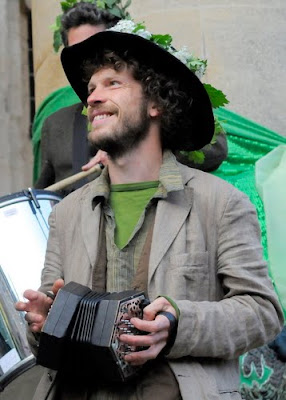Here I am with Nomi, looking a bit bleary as it's 5.30am and we've already been up for an hour, ready to take to the streets (you'll have to ask Nomi who her character is, but yes, that is a raven's claw about her neck).

Look at British folk customs, and you'll often see someone dressed in tailcoat, top hat, flowers and feathers, with a painted face. It's important to remember that when it comes to dressing up and folk rites, there's never been one single, overarching meaning. Things change. Border Morris sides explain that they black their faces as a form of disguise, and true enough there's a riotous tradition of popular, rural rebellion that has seen people going out costumed, dressed in drag as 'Rebecca' or as the notorious 'Captain Swing'.
Then again, many folk rites such as the Jack-in-the-Green are of nineteenth century origin, created by chimney sweeps to earn a bit of cash as their work dried up in the spring - blacked faces being the mark of their profession. But we also have to accept that 'blacking up' has occasionally been done for less palatable reasons, and I think as folk artists we have to own up to a past we now find distasteful: to do so is to accept that 'the folk' are not necessarily the repository of progressive attitudes, or, as some have argued, 'the common sense'. By acknowledging the elephant in the room, folk artistry can distance itself from any taint of bigotry and make itself relevant again.
The mask I wear is half black, half white and I'll leave you to read your own meanings into that, but it is also meant to be just a little scary - once I made a small child cry - no one said that ritual should be nice.
This year the Hurly-Burly Band were not only well-rehearsed but we were also joined by Mano, a gaita player from Gallicia, who brought the weight of his tradition to the proceedings (photos by Kate Raworth). With four pipers and a host of others we made a glorious wall of sound.


The crowd was large, as usual, and by the end of our set, when the sun rises above Hertford College, and bathes us in warm morning light, most people were dancing.


On the bank holiday Monday, a small, post-MayDay possee set off on what has now become a traditional walk, the five miles from our flat, through Wytham Woods to Eynsham, stopping off for a picnic on the way. With impeccable timing we heard a cuckoo as we came down through the woods.


We go to Eynsham, not just because it is a lovely walk, but also to see Eynsham Morris do their thing, on their day of dance. They are the real deal. Their tradition is unique to the village - indeed you have to have lived in the village, or preferably to have been born there, to dance. They were one of the first sides to be discovered by Cecil Sharp, and what I like about them is that they dance with a wild gusto, ripping the piss from one another as they do, trying to trip one another up. Proper. No wanky-having here. Oddly, they dance right outside our flat on May 1st, but of course we always miss them. So to Eynsham we go. Some of the men have been dancing since they were children. One man's grandfather was buried in his kit. Most of the men look as if they are made of blackthorn and briar, as if they've sprung from the hedgerows of Oxfordshire.

Like many traditional Morris sides they've been worried that the next generation won't take an interest, but to general relief they've recruited some village lads who've all learned the dances and seem thoroughly to enjoy themselves.


I asked about the feathers and the top hats. All to cock a snook at the aristocracy. The pheasant feathers say, hey, we're poaching your pheasants; the top hats say, we can wear top hats too. Two fingers to authority. Bosky men indeed.









You two look smashing, as do the rest of the revelers! Quite a crowd.... love the line "the men look as if they are made of blackthorn and briar...." the look on the man in the last photos is a bit prickly!
ReplyDeleteWonderful! Andy, I can't tell you how jealous I am! We have nothing like May Day here, even though the majority of the population are Anglo-Saxon...somehow our ancestors left behind all their old traditions as well as the land of their birth when they emigrated. I suppose so many of these traditions are tied to the land and the seasons, but a new land didn't bring new (or composite) traditions. About the only time an Australian bloke will condescend to dressing up for some revelry is a silly hat at the Footy Grand Final. Sigh!
ReplyDeleteBTW, off on a tangent re: the Black and White face. I remember as a teenager seeing an old episode of Star Trek (the original) which featured two aliens with faces painted black and white. They hated each other (one was part of a ruling elite, the other a slave) and were at war, but the crew of the Enterprise couldn't understand what was going on. In exasperation one of them finally cried "can't you SEE, he's black on the LEFT side, I'm black on the RIGHT side!" Star Trek taking on the racists in the 60s! (and no, I'm not a mad trekkie, but that episode stuck in my mind!)
Oh, I meant to ask...which story books of your childhood influenced the Bosky Man character?
ReplyDeleteand I thought Captain Swing was a Michelle Shocked album.
ReplyDeleteGlad to see Nomi still has her Ravenclaw